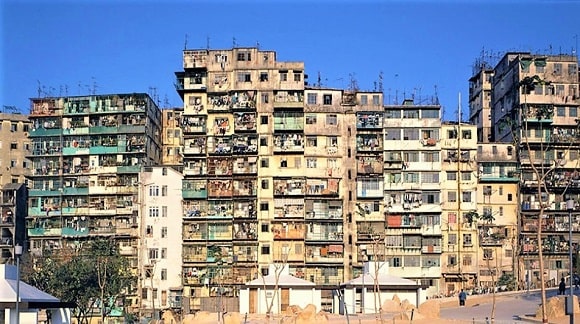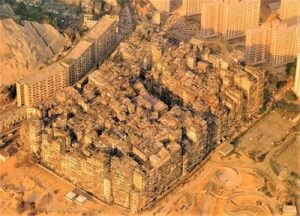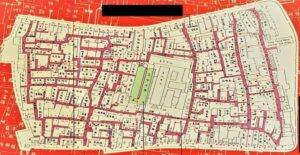
Kowloon Walled City was a largely ungoverned and overpopulated settlement, part of present-day Kowloon in the region of Hong Kong. Originally a military fort of the Qing dynasty, the walled city became a Chinese enclave after the New Territories were leased to the United Kingdom in 1898 from China, excluding the fortified portion.
Its population increased dramatically following the Japanese occupation of Hong Kong during World War II. In 1990 the walled city contained an estimated 50,000 residents within its 2.6 hectares (0.026 km² ) boundaries.
From 1950 to 1970, it was subject to near-total control of the local triads with high rates of prostitution, gambling, and drug abuse. In January 1987 the Hong Kong government announced plans to demolish the walled city.
After an arduous eviction process, demolition began in March 1993 and was completed in April 1994. In December 1995, the “Kowloon Walled City Park” was inaugurated and now occupies the area of the former walled city.
Some historical artifacts of the walled city, including its yamen building and remains of its south gate, have been preserved there.

Kowloon Walled City Facts
- Settled: c. 1898
- Demolished: 1994
- Total Area: 2.6 ha (6.4 acres)
- Country/City:
China (de facto 1898-1912; de jure; 1898–1993)
British Hong Kong (de facto; 1912–1993; sovereignty 1993–1997) - District: Kowloon City District
- Area: Kowloon City
- Population: 50,000 (1990)
Kowloon Walled City History
The Citadel, known as Kowloon when it was first established, was established during the Song Dynasty (960–1279) when it served as the region’s observation post against pirates and as a center for the management of salt production.
It was rebuilt as a fortress in the middle of the 19th century on the same site. After the cession of Hong Kong Island to the British in 1842 (Nanjing Treaty), the Chinese imperial authorities deemed it necessary to establish a military observation post to dominate the peninsula and periodically check for possible expansion of English influence in the area.
In 1898, a Convention was signed that transferred other portions of the Chinese territory of Hong Kong to the English, for an additional 99 years. The Convention excluded the Kowloon Citadel (then with a population of around 700 people), which remained in the domain of China, which could maintain troops on the peninsula, provided they did not interfere with English activities.
The English Crown soon disregarded this part of the agreement, attacking Kowloon in 1899, but finding it completely deserted. Nothing was done with the Citadel and the question of its ownership was left in the background.
Around 1940, the Citadel became a highly populated neighborhood, all concentrated within its walls. The enclave remained part of Chinese territory despite China’s intense political changes (fall of the Qing Dynasty, the establishment of the Republic, and, finally, the advent of Communism)
The citadel remained a curiosity and a tourist attraction for English settlers and tourists, who could feel, visiting its alleys, as was China of ancient times. With the occupation of Hong Kong in 1940, during the Second World War, the Empire of Japan evacuated the citadel and demolished it almost completely (including its walls), in order to obtain building materials for military works.
After the Japanese surrender, the citadel resisted several English attacks, until 1948, for them to vacate it. With no walls to protect it, Kowloon became a safe haven for bandits, robbers, and opium addicts, as Hong Kong police had no right to enter the Citadel and mainland China refused to address the issue.
With the definitive establishment of Chinese Communism in 1949, thousands of refugees (predominantly from Canton) emigrated to Kowloon. The English Crown was already fed up and started to adopt a more interventionist position in the Citadel.
An assassination inside the walls in 1959 sparked a small diplomatic crisis and the two nations tried to hold each other responsible for the territory, then completely dominated by the anti-Manchurian Triads (Hong Kong’s organized crime syndicate).
The rule of the Chinese Triads lasted until the mid-1970s, when in the 1973-1974 biennium, about 3,000 police raids took place in Kowloon Citadel, brutally weakening the power of such criminal organizations.
Kowloon Walled City Demolition
Over time, both the British and Chinese governments found the city increasingly intolerable despite the reduction in the reported crime rate. The quality of life insanitary conditions in the city in particular lagged far behind the rest of Hong Kong. The Sino-British Joint Declaration in 1984 laid the groundwork for the demolition of the city.
The mutual decision of the two governments to tear down the walled city was announced on January 14, 1987. 16On March 10, 1987, following the announcement that the walled city would become a park, the District Administration Secretary formally requested the Urban Council to take over the site after the demolition.
Due to the presence of numerous other green spaces in the area, the Department of Urban Services doubted the need for “another park” from a planning and operations point of view, but the council agreed to accept the government’s proposal on the condition of that the government assumes the cost of the construction of the park.
The government distributed some HK $2.7 billion (USD $350 million) in compensation to the estimated 33,000 residents and businesses in a plan devised by a special committee of the Hong Kong Housing Authority.
Some residents were not satisfied with the compensation and were forcibly evicted between November 1991 and July 1992. After four months of planning, the demolition of the walled city began on 23 March 1993 and concluded in April 1994. The construction work of the Kowloon Walled City park started in on the site.
Kowloon Walled City Park
The area that was once Kowloon Walled City is now Kowloon Walled City Park. It is adjacent to Carpenter Road Park. The 31,000 m 2 park was completed and turned over to the local government in August 1995.
It was officially opened a few months later, on December 22, by Governor Chris Patten. The construction of the park cost a total of HK $76 million. The park’s design is inspired by the Jiangnan Gardens of the early Qing dynasty.
The park is divided into eight different gardens, with the fully restored yamen as the main attraction. The park’s paths and pavilions are named after the streets and buildings of the former city. Remains from the city are also on display, such as five carved stones and three old wells.
The park was designed by the Architectural Services Department, which received a ‘prestigious award’ from the German Central Society of Horticulture for this.
Kowloon Walled City Map
The Kowloon Walled City in Hong Kong looks like a beehive, with cramped quarters stacked casually on top of one another. It grew up organically, clearly constructed without an architect.
In March 1993, before its demolition, the city is packed with life. Kowloon walled city inside was filled with many prostitutes, gangsters, hawkers, and garbage pickers.
Here is the Kowloon Walled City map:

I like the helpful info you provide in your articles.
I’ll bookmark your weblog and check again here regularly.
I’m quite sure I’ll learn a lot of new stuff right here!
Best of luck for the next!